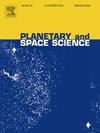Using imagery from the Mars Science Laboratory mission to understand wind properties of aerosols aloft
IF 1.7
4区 物理与天体物理
Q3 ASTRONOMY & ASTROPHYSICS
引用次数: 0
Abstract
Since landing in 2012, the Mars Science Laboratory (MSL, Curiosity) has been investigating local aerosols through atmospheric imagery taken by its onboard Navigation Cameras (NCAMs). In particular, a Zenith Movie (ZM), is a vertically pointed 8-frame movie that is used to classify meteorological wind direction based on aerosol movement within the frames. Several Mars Year (MY) worth of data have been analysed and found repeatable wind directions year-to-year. Water-ice clouds in the Aphelion season had strong Easterly winds, which agrees with modelling that shows a strong cross-equatorial Hadley cell in this season. The Perihelion season did not show any strong directions, which was attributed to the chaotic motion seen in dust clouds expected during this season. When compared to the Rover Environmental Monitoring Station (REMS) onboard MSL, wind directions from the ZMs did not agree with REMS results. This mismatch between REMS and ZM wind results indicates that aerosols observed in imagery are most likely well above the crater rather than at the surface where REMS is located.
利用火星科学实验室任务的图像来了解高空气溶胶的风特性
自2012年登陆火星以来,火星科学实验室(MSL,好奇号)一直在通过其机载导航相机(NCAMs)拍摄的大气图像调查当地的气溶胶。特别是,Zenith Movie (ZM)是一个垂直指向的8帧Movie,用于根据帧内的气溶胶运动来分类气象风向。对几个火星年(MY)的数据进行了分析,发现每年都有可重复的风向。远日点季节的水冰云有很强的东风,这与模型显示的这个季节有很强的横跨赤道的哈德利环流相一致。近日点季节没有显示出任何强烈的方向,这归因于在这个季节预计会出现的尘埃云的混乱运动。当与MSL上的漫游者环境监测站(REMS)进行比较时,来自ZMs的风向与REMS的结果不一致。REMS和ZM风结果之间的不匹配表明,在图像中观察到的气溶胶很可能在陨石坑上方,而不是在REMS所在的表面。
本文章由计算机程序翻译,如有差异,请以英文原文为准。
求助全文
约1分钟内获得全文
求助全文
来源期刊

Planetary and Space Science
地学天文-天文与天体物理
CiteScore
5.40
自引率
4.20%
发文量
126
审稿时长
15 weeks
期刊介绍:
Planetary and Space Science publishes original articles as well as short communications (letters). Ground-based and space-borne instrumentation and laboratory simulation of solar system processes are included. The following fields of planetary and solar system research are covered:
• Celestial mechanics, including dynamical evolution of the solar system, gravitational captures and resonances, relativistic effects, tracking and dynamics
• Cosmochemistry and origin, including all aspects of the formation and initial physical and chemical evolution of the solar system
• Terrestrial planets and satellites, including the physics of the interiors, geology and morphology of the surfaces, tectonics, mineralogy and dating
• Outer planets and satellites, including formation and evolution, remote sensing at all wavelengths and in situ measurements
• Planetary atmospheres, including formation and evolution, circulation and meteorology, boundary layers, remote sensing and laboratory simulation
• Planetary magnetospheres and ionospheres, including origin of magnetic fields, magnetospheric plasma and radiation belts, and their interaction with the sun, the solar wind and satellites
• Small bodies, dust and rings, including asteroids, comets and zodiacal light and their interaction with the solar radiation and the solar wind
• Exobiology, including origin of life, detection of planetary ecosystems and pre-biological phenomena in the solar system and laboratory simulations
• Extrasolar systems, including the detection and/or the detectability of exoplanets and planetary systems, their formation and evolution, the physical and chemical properties of the exoplanets
• History of planetary and space research
 求助内容:
求助内容: 应助结果提醒方式:
应助结果提醒方式:


